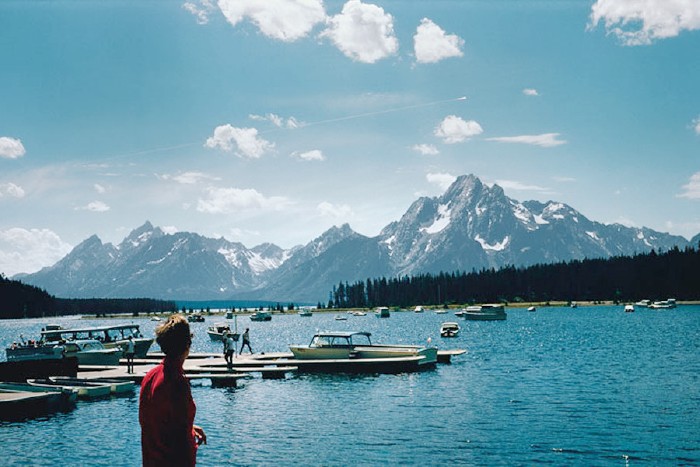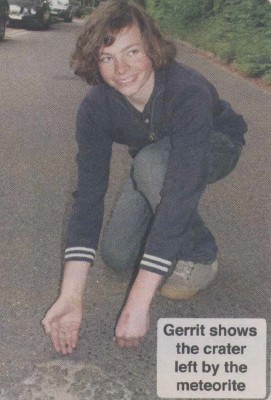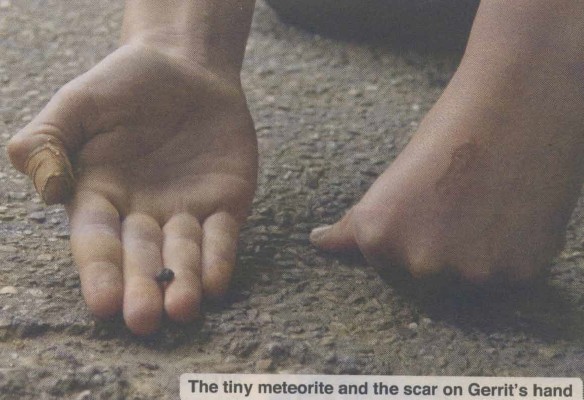The nights from about 15th to 20th of November each year are the best time for seeing lots of shooting stars (or falling stars to American children), and Sam and his friends are waiting for a clear night to watch them.
The correct name for a shooting star is a meteor. You can actually see three or four meteors an hour on any clear night, but you have to be very patient. But at certain times of the year we have a meteor shower, with several meteors every minute, and all starting from the same point in the sky. The one in the middle of November is called the Leonids because all the meteors start in the constellation of Leo.
Meteors are caused by space dust and other space debris coming into the Earth’s atmosphere at very high speeds and being heated up by air friction. The meteor is actually the streak of light, the object causing it is called a meteoroid. Most meteoroids burn up or disintegrate completely in the Earth's atmosphere, or go back into space, but a few do hit the surface of the Earth, these are called meteorites.
The Solar System consists not only of the Sun, the Earth and Moon and the other planets and their moons but also many other objects: particles of rock and dust, asteroids and comets, and lots of other things left behind when the Sun and the planets and their moons were formed. These objects range in diameter from less than 1 mm to more than 100 km. The meteoroid creating the meteor in the picture above was probably about the size of a marble.
These objects are all orbiting the Sun, like the Earth and the other planets, but their orbits are affected not only by the Sun’s gravity but also by the gravity of everything else in the Solar System, including the Earth’s. Sometimes this can change the orbit of one of these objects so that it may come nearer the Earth. As it gets nearer the Earth
The object may be approaching the Earth at more than 40 000 km/hr. If it comes within about 100 km of the Earth’s surface air friction will heat it to a very high temperature, and it will leave a streak of light across the sky. Few meteors are bright enough to be seen during the day, and the trails are seldom visible for more than a second, but on a clear night you should see at least one every fifteen minutes. But you have to be patient and wide awake!
About a hundred tonnes of space dust and small meteoroids (less than 1 m in diameter) enters the Earth’s atmosphere every day. Meteoroids over 1 m in diameter are much less common and may produce a meteor bright enough to make international news - these may be called fireballs.
Of course all the other planets in the Solar System and their moons are also being bombarded in the same way. The effect of this bombardment on the planet or moon depends upon whether it has an atmosphere and what its atmosphere is made of. The Earth’s Moon has no atmosphere so its surface is completely covered with craters made by objects from space hitting it.
Most meteors are produced by small rocks and space dust and cannot be predicted and can appear from anywhere in the sky. We call these sporadic meteors. But at certain times of the year the Earth passes through a cloud of particles, such as the debris left behind by a comet, and then we have a meteor shower, with several meteors every minute, and all of them starting from the same point in the sky (the radiant). We usually name these showers after the name of the constellation containing the radiant. On the night of a meteor shower we just have to look in the direction of this constellation and we shall be sure to see lots of meteors.
Among the best meteor showers are
There is usually something about these showers on television or the web or in the newspapers at the time, and you can find out more about these and other meteor showers by visiting a Meteor Shower web site.
Meteoroids with a diameter of more than 1 m are nearly always asteroids, that is, objects that originally started their journey towards the Earth in the asteroid belt, so the word meteoroid is usually used only for objects smaller than 1 m. (But anything which actually hits the Earth is a meteorite, whatever its size.) Many asteroids just skim the edge of the atmosphere before going back into space. In 1972 an asteroid with an estimated diameter of about 10 m skimmed the atmosphere above the Grand Tetons in Wyoming. Although it was daytime the trail it left was bright enough to be clearly visible, and several tourists were able to photograph it. Here is a photograph taken by James M Baker. You can see the trail more clearly if you enlarge the image a little.

Most meteoroids and asteroids that do not go back into space burn up completely in the Earth's atmosphere. Only a few actually hit the surface of the Earth: we call these meteorites. About a hundred and fifty meteorites hit the Earth every year but most fall in the sea. Only a very few of those which hit the land are big enough to do more than minor damage over a small area.
In the Summer of 2009 a fourteen year old German schoolboy was struck on the hand by a pea-sized meteorite.


The destructive power of an asteroid depends upon its mass, and so its volume. The volume of a sphere depends upon the cube of its diameter, so if we double the diameter of an asteroid we multiply its volume by a factor of two cubed, or eight. So a 2 m diameter asteroid has eight times the destructive power of a 1 m meteoroid, and a 10 m asteroid a thousand times as much! The actual amount of damage an asteroid will do if it hits the Earth as a meteorite depends not only upon its diameter but also upon its speed and the angle at which it enters the atmosphere.
The destructive power of an asteroid is measured in kilotons or Megatons. One kiloton is the destructive power of a thousand tons of TNT, an explosive widely used in bombs during the Second World War. The atom bomb dropped on Hiroshima in 1945 was about 13 kilotons, and a 10 m asteroid would be about 47 kilotons.
Meteorites are important to scientists because they have come from outside the Earth and so they can tell us a lot about other planets and the origins of the solar system. There are three main types of meteorite: stony ones, made of rocks, iron ones, containing iron, and stony/iron ones, containing both rock and iron. Until Man learned how to extract iron from iron ore (about 1200 BCE but see the Page on Metals and Alloys FTPO), iron meteorites were the only source of iron, and objects made of meteoric iron were more valuable than gold. There was a dagger made from meteoric iron in Tutankhamen's tomb. There was also a pectoral (a piece of jewellery worn on the breast) containing a piece of glass formed by an air burst (see below) over the Sahara Desert.
Most solids expand when they are heated, and asteroids are no exception. Usually an asteroid between about 10 m and 100 m in diameter gets so hot that instead of hitting the Earth’s surface as a single meteorite its expansion breaks it up into smaller pieces several kilometres above the Earth: this is called an airburst.
You can demonstrate this effect with a cube of ice from the freezer. When you take it out of the freezer it is at about -20 C, and if you drop it straight into a beaker of water at room temperature it will start to warm up (not immediately melt) and expand and the sudden expansion will cause it to crack, with a loud noise. If you leave it for one or two minutes before you put it into the water it will warm up much more slowly and will not break up. It is very dangerous indeed to do this experiment with anything other than an ice cube.
Air bursts may cause intense heating of the ground directly underneath (enough to melt the desert sand and turn it into coloured glass, see above) and create very powerful shockwaves which can do great damage, but they leave no crater on the surface, so after a few years very little evidence remains. For this reason until recently almost nothing was known about them. But air bursts may be the origins of stories about a fire in the sky which form part of the traditions of Native American and other cultures.
In 1908 the air burst of a 50 m diameter asteroid over Tunguska, a very remote region in Siberia, destroyed 2000 km2 of forest (about the area of London), although because of its remoteness and the impact of the Russian Revolution and the First World War it was not properly investigated for many years.
On February 15th 2013 a 17 m diameter asteroid airburst over Chelyabinsk, a town in the Ural Mountains in Russia. No one was killed but more than a thousand people were injured, mainly by flying glass from windows broken by the shockwave. There are lots of web sites giving more details, even videos. Its mass is estimated as 105 kg (that’s ten and five zeros in standard form FTPO), or about 100 tonnes, but some papers and web pages gave it as 105 kg (only about twice your mass!) You cannot always check that the information on a web site is correct, but you really should always check that it is sensible.Although this asteroid was totally unpredicted its path through the atmosphere was filmed by so many CCTVs and car dashcams, and from an area covering several km², that its trajectory could be plotted very accurately, and from this its orbit before it entered the Earth’s atmosphere and its size and speed could be calculated.
As the asteroid airburst it broke up into thousands of much smaller pieces. Most of these burnt up in the atmosphere and only a very few reached the Earth’s surface. None of these pieces left more than tiny craters or did more than minor damage, but as many as possible are being collected by scientists and local people because, as said above, we can learn a lot about the origins of the Solar System from them.
Asteroids bigger that about 100 m diameter do not usually airburst completely because rock is a very poor conductor of heat and the inside does not have time to get hot enough to break up before it hits the surface. About 50 000 years ago an asteroid about 100 m in diameter entered the atmosphere and the resulting meteorite left a crater more than a kilometre across. To see a picture of this crater you can go to Arizona Crater.
Very rarely indeed, every few million years, a much larger asteroid may hit the Earth. Most scientist believe that the Great Extinction of sixty five million years ago which wiped out all the dinosaurs was the result of an asteroid about 10 km in diameter (the size of Mount Everest) hitting the Earth. This struck the Earth at a place called Chicxulub, in Mexico, and left a crater 180 km across, although of course after 65 million years none of this crater can be detected on the surface.
© Barry Gray last revised August 2020